Energy and Sustainable Development: A Comprehensive Analysis
VerifiedAdded on 2021/09/15
|6
|2110
|48
Report
AI Summary
This report delves into the crucial role of energy in achieving the United Nations' Sustainable Development Goals (SDGs). It examines how energy impacts each of the 17 SDGs, from poverty reduction and hunger eradication to climate action and environmental protection. The report highlights the importance of clean and sustainable energy sources, emphasizing their influence on health, education, gender equality, economic growth, and industrialization. It further discusses the challenges associated with achieving these goals, including funding, increasing energy demands, and the need for global collaboration. The report also suggests solutions such as increased funding for research, promotion of renewable energy, and the adoption of sustainable practices to ensure a sustainable future. The document provides an in-depth analysis of the energy sector's influence on the SDGs, offering insights into the path toward sustainable development and a cleaner, more equitable world.
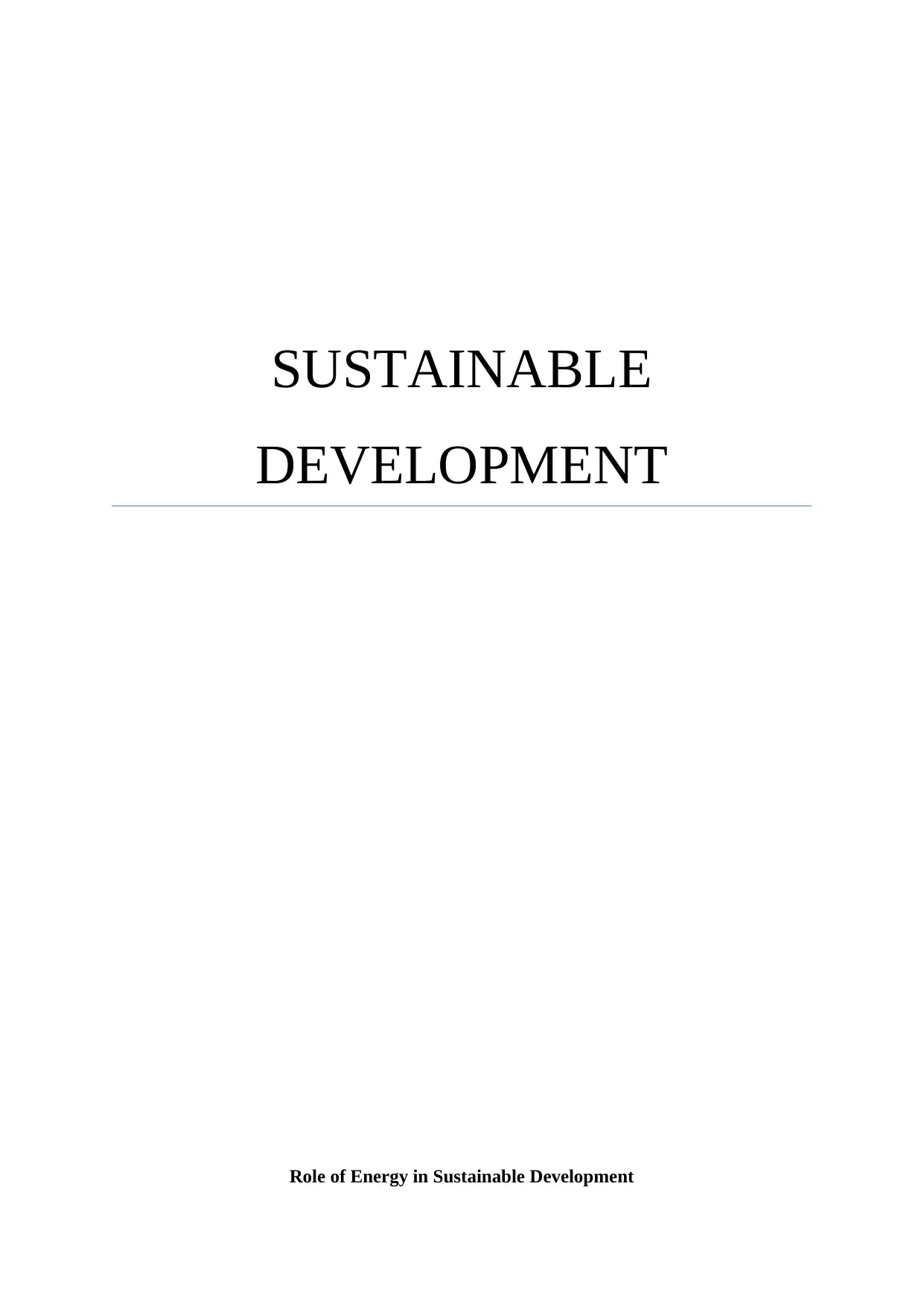
SUSTAINABLE
DEVELOPMENT
Role of Energy in Sustainable Development
DEVELOPMENT
Role of Energy in Sustainable Development
Paraphrase This Document
Need a fresh take? Get an instant paraphrase of this document with our AI Paraphraser
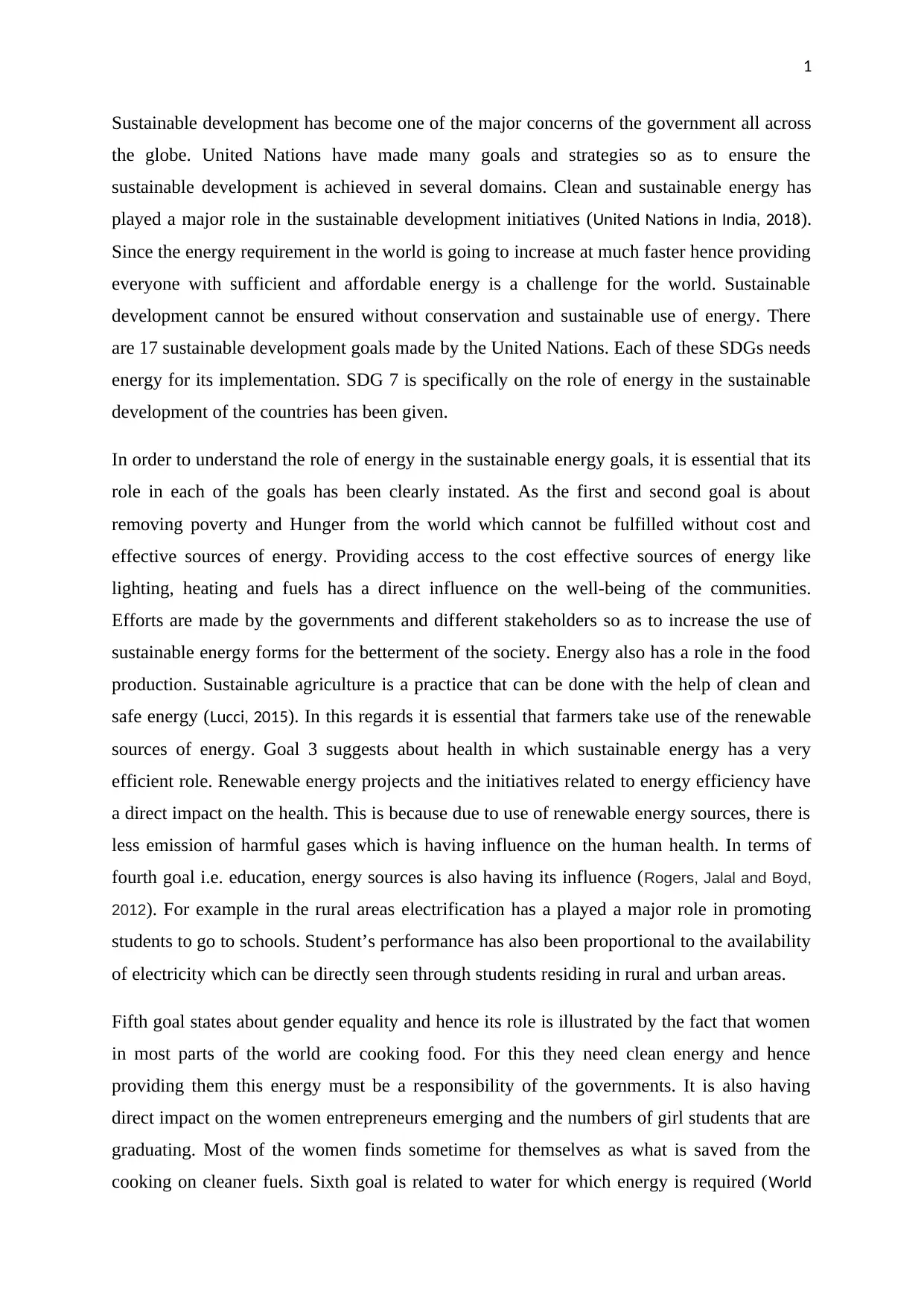
1
Sustainable development has become one of the major concerns of the government all across
the globe. United Nations have made many goals and strategies so as to ensure the
sustainable development is achieved in several domains. Clean and sustainable energy has
played a major role in the sustainable development initiatives (United Nations in India, 2018).
Since the energy requirement in the world is going to increase at much faster hence providing
everyone with sufficient and affordable energy is a challenge for the world. Sustainable
development cannot be ensured without conservation and sustainable use of energy. There
are 17 sustainable development goals made by the United Nations. Each of these SDGs needs
energy for its implementation. SDG 7 is specifically on the role of energy in the sustainable
development of the countries has been given.
In order to understand the role of energy in the sustainable energy goals, it is essential that its
role in each of the goals has been clearly instated. As the first and second goal is about
removing poverty and Hunger from the world which cannot be fulfilled without cost and
effective sources of energy. Providing access to the cost effective sources of energy like
lighting, heating and fuels has a direct influence on the well-being of the communities.
Efforts are made by the governments and different stakeholders so as to increase the use of
sustainable energy forms for the betterment of the society. Energy also has a role in the food
production. Sustainable agriculture is a practice that can be done with the help of clean and
safe energy (Lucci, 2015). In this regards it is essential that farmers take use of the renewable
sources of energy. Goal 3 suggests about health in which sustainable energy has a very
efficient role. Renewable energy projects and the initiatives related to energy efficiency have
a direct impact on the health. This is because due to use of renewable energy sources, there is
less emission of harmful gases which is having influence on the human health. In terms of
fourth goal i.e. education, energy sources is also having its influence (Rogers, Jalal and Boyd,
2012). For example in the rural areas electrification has a played a major role in promoting
students to go to schools. Student’s performance has also been proportional to the availability
of electricity which can be directly seen through students residing in rural and urban areas.
Fifth goal states about gender equality and hence its role is illustrated by the fact that women
in most parts of the world are cooking food. For this they need clean energy and hence
providing them this energy must be a responsibility of the governments. It is also having
direct impact on the women entrepreneurs emerging and the numbers of girl students that are
graduating. Most of the women finds sometime for themselves as what is saved from the
cooking on cleaner fuels. Sixth goal is related to water for which energy is required (World
Sustainable development has become one of the major concerns of the government all across
the globe. United Nations have made many goals and strategies so as to ensure the
sustainable development is achieved in several domains. Clean and sustainable energy has
played a major role in the sustainable development initiatives (United Nations in India, 2018).
Since the energy requirement in the world is going to increase at much faster hence providing
everyone with sufficient and affordable energy is a challenge for the world. Sustainable
development cannot be ensured without conservation and sustainable use of energy. There
are 17 sustainable development goals made by the United Nations. Each of these SDGs needs
energy for its implementation. SDG 7 is specifically on the role of energy in the sustainable
development of the countries has been given.
In order to understand the role of energy in the sustainable energy goals, it is essential that its
role in each of the goals has been clearly instated. As the first and second goal is about
removing poverty and Hunger from the world which cannot be fulfilled without cost and
effective sources of energy. Providing access to the cost effective sources of energy like
lighting, heating and fuels has a direct influence on the well-being of the communities.
Efforts are made by the governments and different stakeholders so as to increase the use of
sustainable energy forms for the betterment of the society. Energy also has a role in the food
production. Sustainable agriculture is a practice that can be done with the help of clean and
safe energy (Lucci, 2015). In this regards it is essential that farmers take use of the renewable
sources of energy. Goal 3 suggests about health in which sustainable energy has a very
efficient role. Renewable energy projects and the initiatives related to energy efficiency have
a direct impact on the health. This is because due to use of renewable energy sources, there is
less emission of harmful gases which is having influence on the human health. In terms of
fourth goal i.e. education, energy sources is also having its influence (Rogers, Jalal and Boyd,
2012). For example in the rural areas electrification has a played a major role in promoting
students to go to schools. Student’s performance has also been proportional to the availability
of electricity which can be directly seen through students residing in rural and urban areas.
Fifth goal states about gender equality and hence its role is illustrated by the fact that women
in most parts of the world are cooking food. For this they need clean energy and hence
providing them this energy must be a responsibility of the governments. It is also having
direct impact on the women entrepreneurs emerging and the numbers of girl students that are
graduating. Most of the women finds sometime for themselves as what is saved from the
cooking on cleaner fuels. Sixth goal is related to water for which energy is required (World
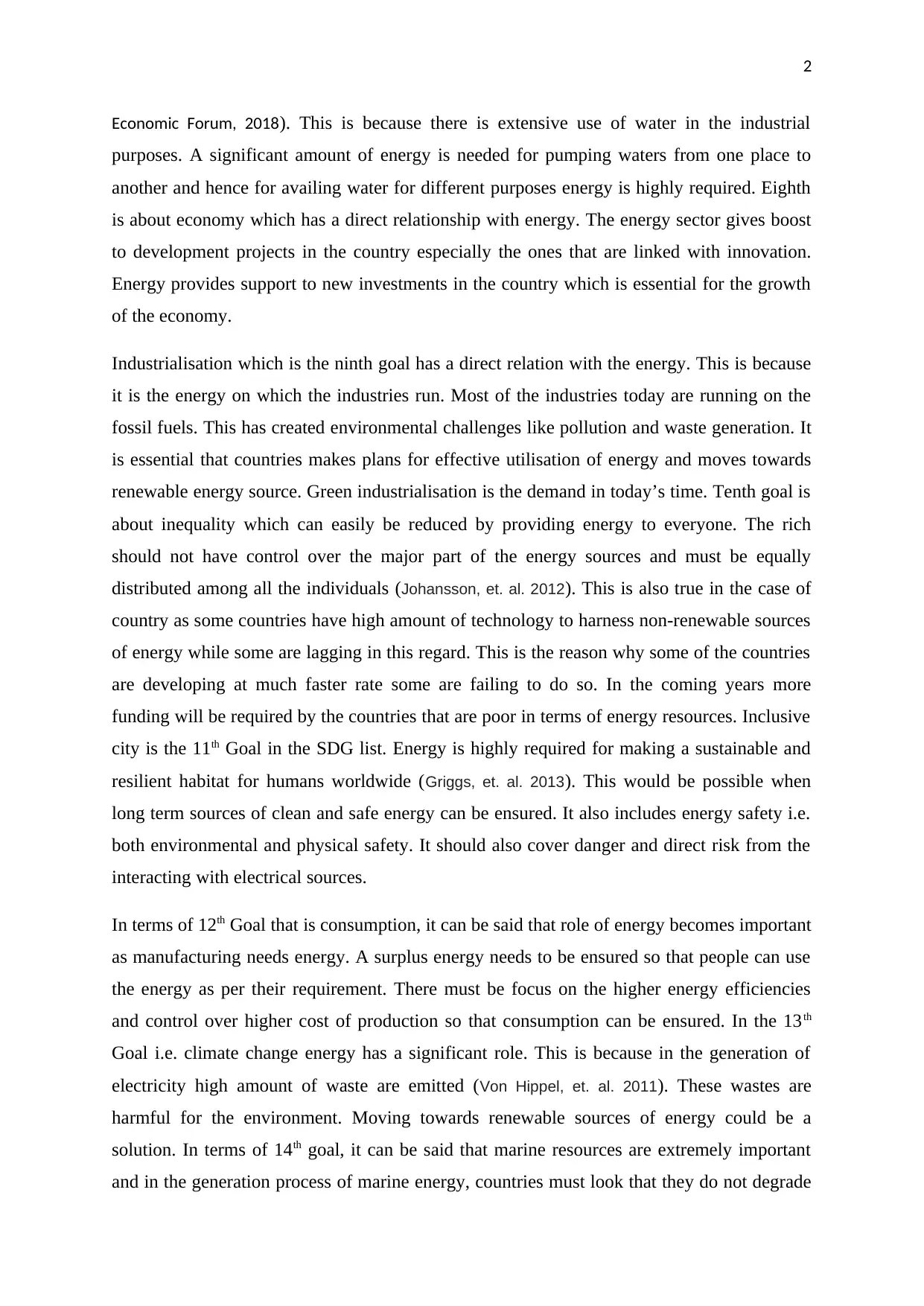
2
Economic Forum, 2018). This is because there is extensive use of water in the industrial
purposes. A significant amount of energy is needed for pumping waters from one place to
another and hence for availing water for different purposes energy is highly required. Eighth
is about economy which has a direct relationship with energy. The energy sector gives boost
to development projects in the country especially the ones that are linked with innovation.
Energy provides support to new investments in the country which is essential for the growth
of the economy.
Industrialisation which is the ninth goal has a direct relation with the energy. This is because
it is the energy on which the industries run. Most of the industries today are running on the
fossil fuels. This has created environmental challenges like pollution and waste generation. It
is essential that countries makes plans for effective utilisation of energy and moves towards
renewable energy source. Green industrialisation is the demand in today’s time. Tenth goal is
about inequality which can easily be reduced by providing energy to everyone. The rich
should not have control over the major part of the energy sources and must be equally
distributed among all the individuals (Johansson, et. al. 2012). This is also true in the case of
country as some countries have high amount of technology to harness non-renewable sources
of energy while some are lagging in this regard. This is the reason why some of the countries
are developing at much faster rate some are failing to do so. In the coming years more
funding will be required by the countries that are poor in terms of energy resources. Inclusive
city is the 11th Goal in the SDG list. Energy is highly required for making a sustainable and
resilient habitat for humans worldwide (Griggs, et. al. 2013). This would be possible when
long term sources of clean and safe energy can be ensured. It also includes energy safety i.e.
both environmental and physical safety. It should also cover danger and direct risk from the
interacting with electrical sources.
In terms of 12th Goal that is consumption, it can be said that role of energy becomes important
as manufacturing needs energy. A surplus energy needs to be ensured so that people can use
the energy as per their requirement. There must be focus on the higher energy efficiencies
and control over higher cost of production so that consumption can be ensured. In the 13th
Goal i.e. climate change energy has a significant role. This is because in the generation of
electricity high amount of waste are emitted (Von Hippel, et. al. 2011). These wastes are
harmful for the environment. Moving towards renewable sources of energy could be a
solution. In terms of 14th goal, it can be said that marine resources are extremely important
and in the generation process of marine energy, countries must look that they do not degrade
Economic Forum, 2018). This is because there is extensive use of water in the industrial
purposes. A significant amount of energy is needed for pumping waters from one place to
another and hence for availing water for different purposes energy is highly required. Eighth
is about economy which has a direct relationship with energy. The energy sector gives boost
to development projects in the country especially the ones that are linked with innovation.
Energy provides support to new investments in the country which is essential for the growth
of the economy.
Industrialisation which is the ninth goal has a direct relation with the energy. This is because
it is the energy on which the industries run. Most of the industries today are running on the
fossil fuels. This has created environmental challenges like pollution and waste generation. It
is essential that countries makes plans for effective utilisation of energy and moves towards
renewable energy source. Green industrialisation is the demand in today’s time. Tenth goal is
about inequality which can easily be reduced by providing energy to everyone. The rich
should not have control over the major part of the energy sources and must be equally
distributed among all the individuals (Johansson, et. al. 2012). This is also true in the case of
country as some countries have high amount of technology to harness non-renewable sources
of energy while some are lagging in this regard. This is the reason why some of the countries
are developing at much faster rate some are failing to do so. In the coming years more
funding will be required by the countries that are poor in terms of energy resources. Inclusive
city is the 11th Goal in the SDG list. Energy is highly required for making a sustainable and
resilient habitat for humans worldwide (Griggs, et. al. 2013). This would be possible when
long term sources of clean and safe energy can be ensured. It also includes energy safety i.e.
both environmental and physical safety. It should also cover danger and direct risk from the
interacting with electrical sources.
In terms of 12th Goal that is consumption, it can be said that role of energy becomes important
as manufacturing needs energy. A surplus energy needs to be ensured so that people can use
the energy as per their requirement. There must be focus on the higher energy efficiencies
and control over higher cost of production so that consumption can be ensured. In the 13th
Goal i.e. climate change energy has a significant role. This is because in the generation of
electricity high amount of waste are emitted (Von Hippel, et. al. 2011). These wastes are
harmful for the environment. Moving towards renewable sources of energy could be a
solution. In terms of 14th goal, it can be said that marine resources are extremely important
and in the generation process of marine energy, countries must look that they do not degrade
⊘ This is a preview!⊘
Do you want full access?
Subscribe today to unlock all pages.

Trusted by 1+ million students worldwide
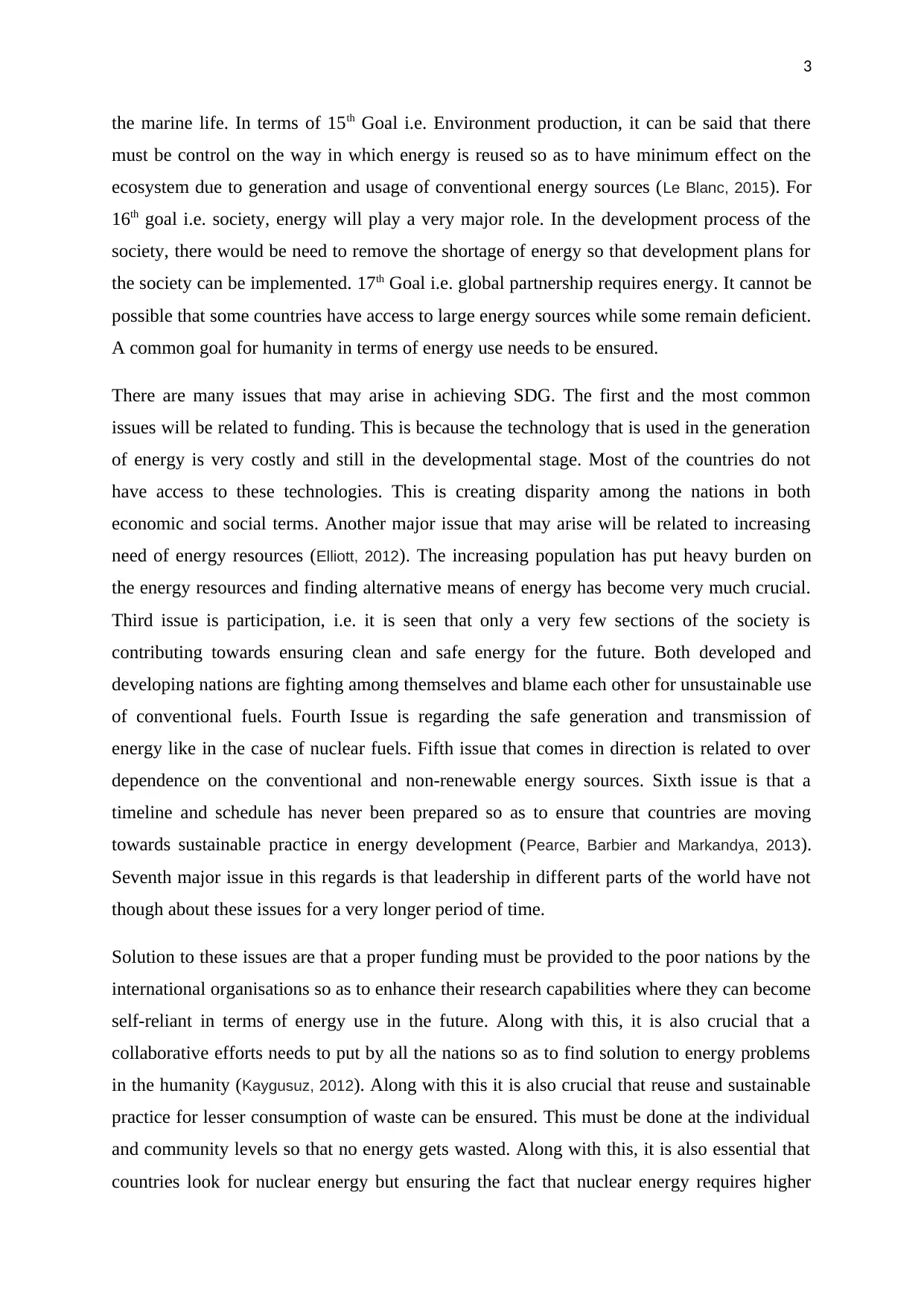
3
the marine life. In terms of 15th Goal i.e. Environment production, it can be said that there
must be control on the way in which energy is reused so as to have minimum effect on the
ecosystem due to generation and usage of conventional energy sources (Le Blanc, 2015). For
16th goal i.e. society, energy will play a very major role. In the development process of the
society, there would be need to remove the shortage of energy so that development plans for
the society can be implemented. 17th Goal i.e. global partnership requires energy. It cannot be
possible that some countries have access to large energy sources while some remain deficient.
A common goal for humanity in terms of energy use needs to be ensured.
There are many issues that may arise in achieving SDG. The first and the most common
issues will be related to funding. This is because the technology that is used in the generation
of energy is very costly and still in the developmental stage. Most of the countries do not
have access to these technologies. This is creating disparity among the nations in both
economic and social terms. Another major issue that may arise will be related to increasing
need of energy resources (Elliott, 2012). The increasing population has put heavy burden on
the energy resources and finding alternative means of energy has become very much crucial.
Third issue is participation, i.e. it is seen that only a very few sections of the society is
contributing towards ensuring clean and safe energy for the future. Both developed and
developing nations are fighting among themselves and blame each other for unsustainable use
of conventional fuels. Fourth Issue is regarding the safe generation and transmission of
energy like in the case of nuclear fuels. Fifth issue that comes in direction is related to over
dependence on the conventional and non-renewable energy sources. Sixth issue is that a
timeline and schedule has never been prepared so as to ensure that countries are moving
towards sustainable practice in energy development (Pearce, Barbier and Markandya, 2013).
Seventh major issue in this regards is that leadership in different parts of the world have not
though about these issues for a very longer period of time.
Solution to these issues are that a proper funding must be provided to the poor nations by the
international organisations so as to enhance their research capabilities where they can become
self-reliant in terms of energy use in the future. Along with this, it is also crucial that a
collaborative efforts needs to put by all the nations so as to find solution to energy problems
in the humanity (Kaygusuz, 2012). Along with this it is also crucial that reuse and sustainable
practice for lesser consumption of waste can be ensured. This must be done at the individual
and community levels so that no energy gets wasted. Along with this, it is also essential that
countries look for nuclear energy but ensuring the fact that nuclear energy requires higher
the marine life. In terms of 15th Goal i.e. Environment production, it can be said that there
must be control on the way in which energy is reused so as to have minimum effect on the
ecosystem due to generation and usage of conventional energy sources (Le Blanc, 2015). For
16th goal i.e. society, energy will play a very major role. In the development process of the
society, there would be need to remove the shortage of energy so that development plans for
the society can be implemented. 17th Goal i.e. global partnership requires energy. It cannot be
possible that some countries have access to large energy sources while some remain deficient.
A common goal for humanity in terms of energy use needs to be ensured.
There are many issues that may arise in achieving SDG. The first and the most common
issues will be related to funding. This is because the technology that is used in the generation
of energy is very costly and still in the developmental stage. Most of the countries do not
have access to these technologies. This is creating disparity among the nations in both
economic and social terms. Another major issue that may arise will be related to increasing
need of energy resources (Elliott, 2012). The increasing population has put heavy burden on
the energy resources and finding alternative means of energy has become very much crucial.
Third issue is participation, i.e. it is seen that only a very few sections of the society is
contributing towards ensuring clean and safe energy for the future. Both developed and
developing nations are fighting among themselves and blame each other for unsustainable use
of conventional fuels. Fourth Issue is regarding the safe generation and transmission of
energy like in the case of nuclear fuels. Fifth issue that comes in direction is related to over
dependence on the conventional and non-renewable energy sources. Sixth issue is that a
timeline and schedule has never been prepared so as to ensure that countries are moving
towards sustainable practice in energy development (Pearce, Barbier and Markandya, 2013).
Seventh major issue in this regards is that leadership in different parts of the world have not
though about these issues for a very longer period of time.
Solution to these issues are that a proper funding must be provided to the poor nations by the
international organisations so as to enhance their research capabilities where they can become
self-reliant in terms of energy use in the future. Along with this, it is also crucial that a
collaborative efforts needs to put by all the nations so as to find solution to energy problems
in the humanity (Kaygusuz, 2012). Along with this it is also crucial that reuse and sustainable
practice for lesser consumption of waste can be ensured. This must be done at the individual
and community levels so that no energy gets wasted. Along with this, it is also essential that
countries look for nuclear energy but ensuring the fact that nuclear energy requires higher
Paraphrase This Document
Need a fresh take? Get an instant paraphrase of this document with our AI Paraphraser

4
safety measures to be taken. It is also necessary that countries finds the ways in which it can
speedily moves towards the renewable energy sources especially at the house hold levels
(Carley, et. al. 2011). More organised approach is required at the international level for
underlining the progress and making balance between the demand and supply of the energy.
safety measures to be taken. It is also necessary that countries finds the ways in which it can
speedily moves towards the renewable energy sources especially at the house hold levels
(Carley, et. al. 2011). More organised approach is required at the international level for
underlining the progress and making balance between the demand and supply of the energy.
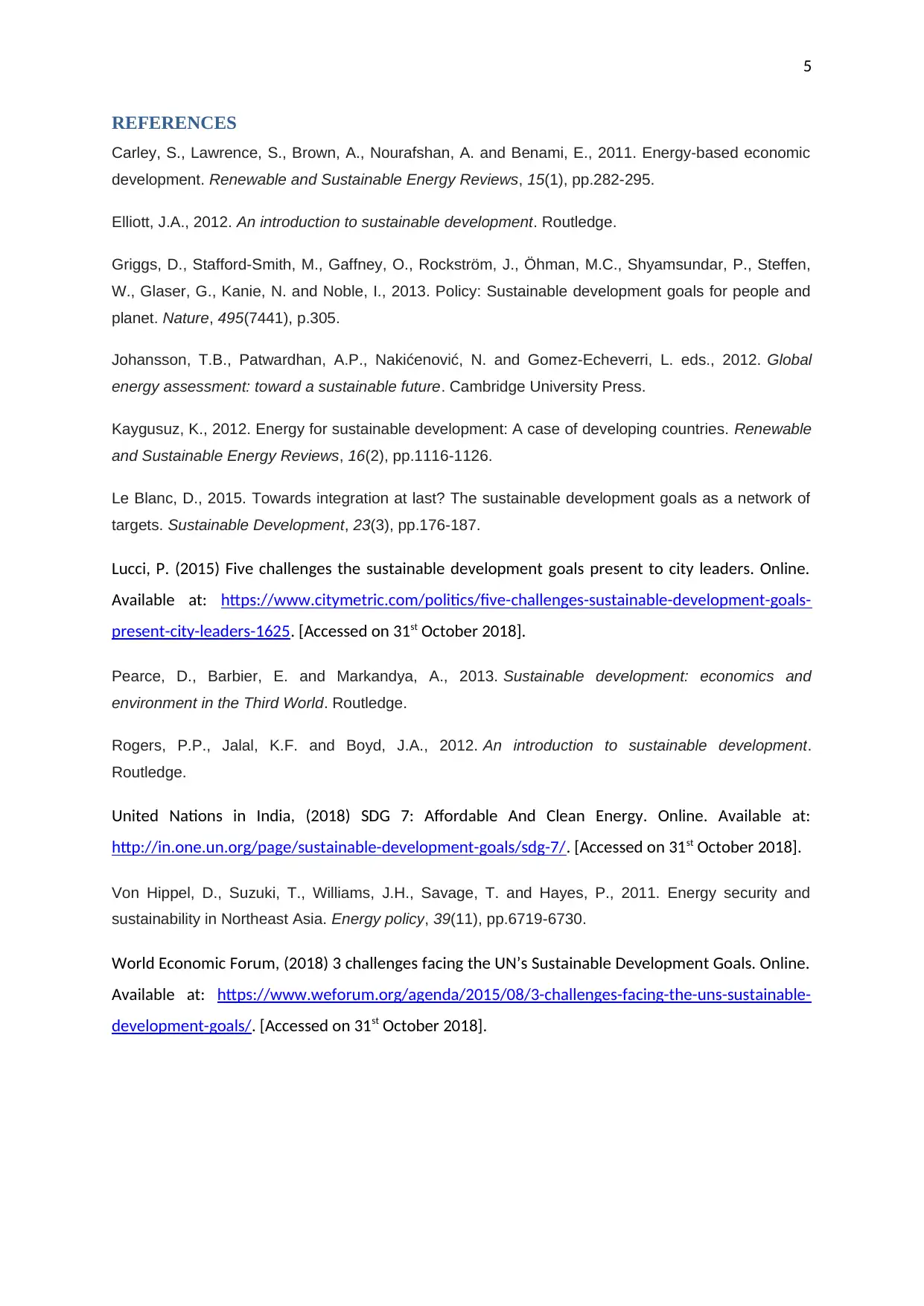
5
REFERENCES
Carley, S., Lawrence, S., Brown, A., Nourafshan, A. and Benami, E., 2011. Energy-based economic
development. Renewable and Sustainable Energy Reviews, 15(1), pp.282-295.
Elliott, J.A., 2012. An introduction to sustainable development. Routledge.
Griggs, D., Stafford-Smith, M., Gaffney, O., Rockström, J., Öhman, M.C., Shyamsundar, P., Steffen,
W., Glaser, G., Kanie, N. and Noble, I., 2013. Policy: Sustainable development goals for people and
planet. Nature, 495(7441), p.305.
Johansson, T.B., Patwardhan, A.P., Nakićenović, N. and Gomez-Echeverri, L. eds., 2012. Global
energy assessment: toward a sustainable future. Cambridge University Press.
Kaygusuz, K., 2012. Energy for sustainable development: A case of developing countries. Renewable
and Sustainable Energy Reviews, 16(2), pp.1116-1126.
Le Blanc, D., 2015. Towards integration at last? The sustainable development goals as a network of
targets. Sustainable Development, 23(3), pp.176-187.
Lucci, P. (2015) Five challenges the sustainable development goals present to city leaders. Online.
Available at: https://www.citymetric.com/politics/five-challenges-sustainable-development-goals-
present-city-leaders-1625. [Accessed on 31st October 2018].
Pearce, D., Barbier, E. and Markandya, A., 2013. Sustainable development: economics and
environment in the Third World. Routledge.
Rogers, P.P., Jalal, K.F. and Boyd, J.A., 2012. An introduction to sustainable development.
Routledge.
United Nations in India, (2018) SDG 7: Affordable And Clean Energy. Online. Available at:
http://in.one.un.org/page/sustainable-development-goals/sdg-7/. [Accessed on 31st October 2018].
Von Hippel, D., Suzuki, T., Williams, J.H., Savage, T. and Hayes, P., 2011. Energy security and
sustainability in Northeast Asia. Energy policy, 39(11), pp.6719-6730.
World Economic Forum, (2018) 3 challenges facing the UN’s Sustainable Development Goals. Online.
Available at: https://www.weforum.org/agenda/2015/08/3-challenges-facing-the-uns-sustainable-
development-goals/. [Accessed on 31st October 2018].
REFERENCES
Carley, S., Lawrence, S., Brown, A., Nourafshan, A. and Benami, E., 2011. Energy-based economic
development. Renewable and Sustainable Energy Reviews, 15(1), pp.282-295.
Elliott, J.A., 2012. An introduction to sustainable development. Routledge.
Griggs, D., Stafford-Smith, M., Gaffney, O., Rockström, J., Öhman, M.C., Shyamsundar, P., Steffen,
W., Glaser, G., Kanie, N. and Noble, I., 2013. Policy: Sustainable development goals for people and
planet. Nature, 495(7441), p.305.
Johansson, T.B., Patwardhan, A.P., Nakićenović, N. and Gomez-Echeverri, L. eds., 2012. Global
energy assessment: toward a sustainable future. Cambridge University Press.
Kaygusuz, K., 2012. Energy for sustainable development: A case of developing countries. Renewable
and Sustainable Energy Reviews, 16(2), pp.1116-1126.
Le Blanc, D., 2015. Towards integration at last? The sustainable development goals as a network of
targets. Sustainable Development, 23(3), pp.176-187.
Lucci, P. (2015) Five challenges the sustainable development goals present to city leaders. Online.
Available at: https://www.citymetric.com/politics/five-challenges-sustainable-development-goals-
present-city-leaders-1625. [Accessed on 31st October 2018].
Pearce, D., Barbier, E. and Markandya, A., 2013. Sustainable development: economics and
environment in the Third World. Routledge.
Rogers, P.P., Jalal, K.F. and Boyd, J.A., 2012. An introduction to sustainable development.
Routledge.
United Nations in India, (2018) SDG 7: Affordable And Clean Energy. Online. Available at:
http://in.one.un.org/page/sustainable-development-goals/sdg-7/. [Accessed on 31st October 2018].
Von Hippel, D., Suzuki, T., Williams, J.H., Savage, T. and Hayes, P., 2011. Energy security and
sustainability in Northeast Asia. Energy policy, 39(11), pp.6719-6730.
World Economic Forum, (2018) 3 challenges facing the UN’s Sustainable Development Goals. Online.
Available at: https://www.weforum.org/agenda/2015/08/3-challenges-facing-the-uns-sustainable-
development-goals/. [Accessed on 31st October 2018].
⊘ This is a preview!⊘
Do you want full access?
Subscribe today to unlock all pages.

Trusted by 1+ million students worldwide
1 out of 6
Related Documents
Your All-in-One AI-Powered Toolkit for Academic Success.
+13062052269
info@desklib.com
Available 24*7 on WhatsApp / Email
![[object Object]](/_next/static/media/star-bottom.7253800d.svg)
Unlock your academic potential
Copyright © 2020–2025 A2Z Services. All Rights Reserved. Developed and managed by ZUCOL.



